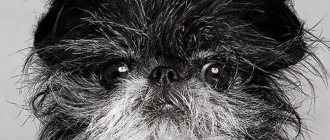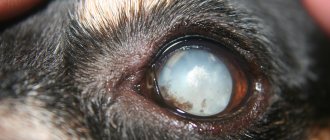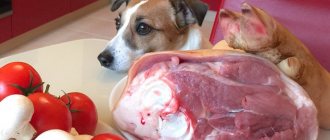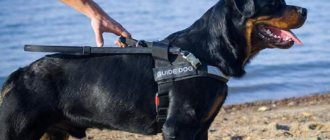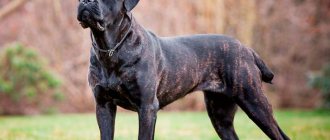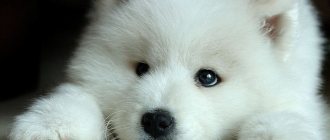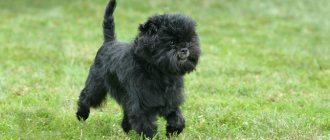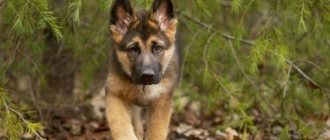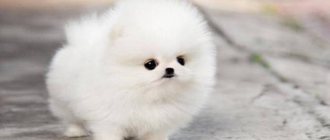Small dogs with an exotic appearance, which literally translated from German are called “monkey pinscher”, at first sight evoke delight and tenderness among others. They were bred to hunt rodents; over time, Affenpinschers turned into companion dogs, but the qualities genetically inherent in them - loyalty, devotion to the owner - are still preserved.
History of the Affenpinscher breed
The southern regions of Germany are considered the homeland of Affenpinschers, where dogs with monkey faces were bred as rat catchers. The residents of Lübeck were especially successful in this, inhabiting grain barns and stables with mini-dogs, where they were engaged in the destruction of rodents. It is worth noting that the first Affens were larger than their modern descendants and had a wider palette of colors, which did not prevent them from transforming into a decorative breed and charming the European nobility. Moreover, by the 19th century, Affenpinschers had become an expensive and sought-after product, which helped German merchants sell them to ignorant foreigners at the incredible price of 1 thaler for that time.
The first clear descriptions of the breed’s appearance date back to the 17th century, but images of Affenpinschers appeared even earlier. For example, funny cosmatics can be seen on the canvases of the German engraver Albrecht Durer and other artists of the Middle Ages. Since no documents declassifying information about the genes of animals have been preserved, the relationship of the Affen with other breeds remains unknown. And although the official version says that monkey-like pinschers appeared by crossing ordinary pinschers with Asian pug-like dogs, the possibility of admixture of other blood in their phenotype is still not excluded.
In 1902, Affenpinschers underwent preliminary standardization, and in 1913 they were officially registered in Germany. The English cynological associations included the breed in the stud books only in 1936, since its representatives were not popular among British breeders. But in the USA, Affens were accepted almost immediately after the presentation - in 1935, a “batch” of shaggy dogs crossed the Atlantic, and a year later received recognition from the American Kennel Club.
The Second World War caused significant damage to the breed's population, so in the 50s the number of dogs in Germany had to be restored almost from scratch. The first Affenpinscher arrived in Russia with the motorcade of the future Empress Catherine II. According to legend, the shaggy creature was taken to guard the wardrobe of the crowned lady, which mice began to encroach on on the way. As for breeding specimens, they began to be imported in the late 90s, but for almost ten years mini-pinschers in Russia remained a living exotic.
A little bit of history
This breed is one of the most ancient among all terriers. The first mentions appeared back in 1800. True, at that time the dog had a slightly different name, but after crossing the English Wirehaired Terrier with the Bedlington Terrier, the Lakeland was obtained.
The breed appeared in England for hunting foxes, badgers, etc. The dog could catch up with prey on uneven terrain, in a forest or field, as well as near water. The first exhibition was in 1912, it was then that the first breed standard was adopted. The latest changes to the Lakeland Terrier standard were made in 2009. As noted above, today a dog of this breed is practically not used for hunting; it acts as a companion and participates in exhibitions.
Affenpinscher breed standard
The Affenpinscher is a shaggy cutie with intelligent button eyes and a charming shaggy face, adorned with a bushy mustache and a scraggly beard. The overall “toy-like” appearance of the animal is enhanced by its square body, as well as its small height - only 25-28 cm with an average body weight of 4-6 kg. The Affenpinscher behaves with dignity and seriousness, which only adds charm to his already funny image.
Head
Representatives of the breed have a round, dome-shaped skull with a well-defined forehead and stop.
Jaws, teeth, lips
The teeth are white, 42 in number. The incisors are arranged in a slightly rounded row, and the lower jaw has a slight curve and is slightly extended above the upper. With the mouth closed, the dog's canines and incisors are not visible. The missing pairs PM1, PM2 and PM3 are allowed by the standard. The Affenpinscher's lips are black, without dampness.
Nose
The black, rounded lobe is distinguished by good fullness and wide open nostrils. The bridge of the nose is shortened, elongated in a straight line.
Eyes
The large, almost round eyes of the Affen are dark in color. The black folds of the eyelids along the contour are covered with coarse hair.
Ears
The ears are set high and symmetrically and turned forward, the inner edge of the ear flap is pressed to the head. It is prohibited to crop the ears of show animals, so this procedure is practiced mainly by owners of pets who want to give the appearance of their ward even more expressiveness.
Neck
The Affenpinscher's neck is massive at the base, short and strong, and has no skin folds on the throat.
Frame
The dog's body is moderately dense, resembling a square. The top is slightly sloping, the back muscles are developed and strong. A strong, shortened loin transitions into an equally short croup with a smooth, rounded outline. The chest is of normal width, descending to the joints, with flattened sides. The lower abdomen is tucked and almost parallel to the line of the back.
Limbs
The front legs are level, moderately wide; the rear ones are set at a slight angle (when viewed from the side) and have moderate articulation angles. The animal's shoulder blades are flat, long, located at an angle of 45°. Elbows without turning outward or inward, metacarpus vertically set, barely sloping, muscular. Volumetric, developed hips are also considered a characteristic of thoroughbred breeding. The Affenpinscher's shins are powerful and long, with vertical metatarsals. The dog's front paws are compact and rounded, the hind paws are more elongated in length, with tightly packed and curved toes.
Tail
From birth, the Affenpinscher's tail is saber- or crescent-shaped. Previously, dogs had their tails docked. Today, cynological associations in Europe have banned the procedure, but in Russia there are still breeders who practice docking of non-show pets.
Wool
The Affenpinscher has coarse, thick hair that lies tightly to the body, but stands up randomly on the head and forms fluffy sideburns, eyebrows, mustaches and a goatee.
Color
The FCI recognizes the standard color of the breed as solid black, with patches of white fur being highly undesirable. However, according to the AKC standard, Affenpinschers can have silver, red, black and tan or grayish coats.
Defects and disqualifying defects
The exhibition evaluation of an Affenpinscher is influenced by such conformation defects as an upturned griffon-like muzzle, light bone structure, pincer-like bite or an undershot with a pronounced waste. It is prohibited to display the following animals in the ring:
- height higher or lower than specified by the standard by more than 2 cm;
- suffering from any deformities of appearance;
- having distorted jaws and a scissor bite;
- having defects in color, coat structure and general structure;
- exhibiting cowardly or aggressive behavior.
Lakeland head appearance
The expression in a dog's eyes changes depending on his mood. In the normal state, the look is wary, but can be cheerful. The eyes are oval-shaped, rather small and widely set. Usually the color of the eyes depends on the coat. For example, liver-colored individuals have dark hazel or brown eyes. In dogs of other colors, the color varies over a wide range. The ears are usually small and resemble an equilateral triangle. They are folded not in the center, but closer to the base of the skull. The transition from forehead to muzzle is practically invisible. The Lakeland's head is quite strong and powerful. Experts usually pay special attention to the proportions of the head, since this is how the selection value of the breed is indicated. Disadvantages include: brown nose, wedge-shaped head, long or short muzzle, etc.
Affenpinscher character
The Affenpinscher is almost 4 kilograms of self-confidence, alertness and devotion, packed into a tough, shaggy fur coat. Usually the breed is fixated on its own relationships with the owner and tries to prevent third parties from getting into them. This is expressed differently in each individual. Some Affens do not favor children and start military battles with children over toys. Others aggressively bark at strangers who have invaded the apartment, not disdaining attempts to make a hole in the sock of an unknown civilian who has occupied the owner’s territory.
The Affenpinscher can also damage the nervous system of pets. If, in addition to the dog, you also keep a cat at home, try to pet it in those rare moments when the affen is not looking. The mustachioed jealous man will not forgive such “betrayal”, and therefore will certainly develop and put into action an act of revenge, in which the cat will be assigned an extremely unenviable role. It’s also not easy with hamsters and chinchillas. Don’t forget that the ancestors of Affenpinschers made their careers precisely by catching and killing rodents, so either keep the fluffies in cages under strict supervision, or place the animals in safe hands until the sharp dog teeth get to them.
When communicating with its owner, the Affenpinscher puts on the mask of a handsome gambling addict, ready to do anything to please his older friend. At the same time, the breed does not know how to impose itself and fawn. For example, if you let your pet know that you are not ready to participate in his projects, the affen will not beg for attention, but will quietly and peacefully step aside and come up with new entertainment for himself. In addition, Affenpinschers are avid travelers, ready to accompany a person both in the back seat of a car and in a bicycle basket. Breeders joke that with the breed you can save on the purchase of a car alarm - the Affen will not miss a single living soul that approaches the car at least a meter.
Watching the active games of the Affenpinscher and the manic persistence with which he pesters other pets, it begins to seem that the animal is a small “ghost with a motor” whose energy cannot be tamed. In fact, the dog’s activity is easily adjusted. Moreover, in company with the owner, the Affenpinscher is not averse to lying down or being distracted by watching a TV series. The main thing is that passive relaxation does not dominate active pastime - an Affen will never sign up for aimless laziness.
Advantages and disadvantages
Before you get a “mustachioed imp,” you need to take into account all the positive and negative aspects of this breed. We present the main ones in table form.
| pros | Minuses |
| suitable for apartment living | loud barking |
| trains well | stubbornness, struggle for dominance in the house |
| devotion to the owner | does not get along well with other pets and small children |
| easy to care for | needs constant walking |
| attractive appearance | due to the small distribution of the breed, it is difficult to find a partner for mating |
| good health | prone to injury |
If a dog with these characteristics meets the capabilities and needs of all family members, you can go for a puppy.
Education and training
The Affenpinscher is an incredibly charming creature, and almost equally stubborn and disorganized. It’s hard to imagine, but if you don’t take care of raising your pet, then the Affen is capable of thoroughly ruining the life of the owner, and for the company of those around him. As soon as a tiny cat shows up in the house, begin to socialize it and accustom it to the fact that in the world, in addition to treats, affection and games, there are also requirements and prohibitions.
One of the first habits an Affenpinscher puppy should develop is following a daily routine. Immediately after moving from the kennel, teach your dog to come for food at a certain time, showing your baby how to take a bowl and how to prepare a meal for him. The ability to politely accept food also does not develop immediately. Be sure to teach your puppy not to jump on you when you are carrying lunch. Yes, the Affen is not a Boerboel and won’t knock you down, but he has enough strength to “help” spill food.
Experienced breeders recommend not to be impressed by the “toy” nature of the breed and treat the Affenpinscher as if this were an average dog. There should also be no lisps or tears of tenderness, otherwise the dog will quickly figure out how to take advantage of it. It is best to practice useful skills in a playful way. The Affenpinscher quickly becomes interested in a new activity and just as quickly loses interest in it, so divide the lesson into short five-minute sessions, with long pauses between them.
It is recommended to select a place for studying with a minimum of distractions. For example, it is more convenient to conduct the first lessons in a room, access to which will be blocked for other animals and family members. Attempts to train a young Affen outdoors usually end in failure. Concentrating on the demands of a person when there are so many tempting smells and sounds around is an impossible task for a puppy. It is better to stimulate an animal to further success in learning using positive reinforcement. What exactly will play this role - a delicacy or affection - each owner decides for himself.
It is more difficult to form a system of prohibitions in an Affenpinscher. Instead of treats, you will have to add some light negativity so that the dog learns to make the connection between your dissatisfaction and its own actions. In this case, the puppy’s sudden attacks should be corrected by intonation or by depriving him of communication, but not by shouting or physical force. In particular, a properly trained Affenpinscher should not grab guests’ legs, tear balls from a person’s hands with his teeth, bite his fingers, or wage war with a vacuum cleaner in an attempt to rip the hose.
You will also have to work hard to develop the skill of using a tray. In order for the puppy to learn the difference between the living space and the indoor toilet, it is recommended to put the baby in the crate several times during the day. The pet perceives the space limiter as a resting place, so it will not leave puddles in it. After sitting in the enclosure (no more than half an hour), it is recommended to escort the dog to the tray.
Reviews
Many Affenpiccher owners speak positively about them; they say that with the advent of the four-legged dog, their life has become more interesting and better.
Some people say that when they were little, their pet chewed all the furniture in the house, but the positive emotions from interacting with it outweigh the disadvantages. For some, daily brushing is difficult, because otherwise hair flies everywhere.
Feeding the creature is simple, as is caring for it. She loves to walk in nature and enjoys going to the dacha; almost everyone catches rats and mice there. If you go for a walk without a leash, a shaggy dog can chase a bird or a cat without hearing any calls from the owner; if he is still very young, when training, many advise to do without punishment, and to act only with the carrot method.
Maintenance and care
The inquisitive and reactive Affenpinscher does not need spacious apartments - an average apartment is enough for him, in which there is enough space for his bowl and bed, as well as for the owner’s sofa. The breed also does not require any specific equipment, with the exception of an indoor enclosure, which is necessary for those cases when the puppy will have to be left completely alone. But the Affen really needs toys: at a young age - for development and practicing commands, in adulthood - for relaxation.
Hygiene
According to the English Kennel Club standard, the Affenpinscher has a coarse coat 2.5 cm long, which does not require trimming. However, in practice, dogs have to be pinched, because the rare Affen has a perfect coat by nature. Once every few months, it is necessary to remove the “overripe” wool, and this can be done manually (stripping) or using a stripping knife. It is not recommended to get too carried away with the process and pluck out all the loose hair. The specialty of the breed is precisely its shaggy appearance, and too careful trimming will only worsen the situation.
The hair on the Affenpinscher's face is lightly trimmed with scissors, giving the head a ball shape. Pets' beards are also shortened for hygiene purposes. By lowering its head into the bowl, the dog will not stain the hair on the lower jaw, and accordingly, the owner will not have to constantly wipe the pet’s chin. However, this method will not work with show animals, just like stripping - Affenpinschers that clearly show signs of recent trimming or haircut are fined in the rings.
It is better to shorten the hair on the inside of the dog’s ear, as well as in the anal area. If the dog is overgrown, it is useful to remove excess vegetation in the eye area that obscures the animal’s view. Three times a week, it is recommended to comb the affena with a medium-tooth comb, which will remove dead hair, and then massage it with a brush.
Frequent bathing, especially on the eve of an exhibition, is contraindicated for Affenpinschers, but once every 3-4 months the pet can be washed using shampoo and conditioner for wire-haired breeds. Dogs' nails are trimmed once every 4-6 weeks, and teeth are brushed once every 7 days. The dog's eyes must be examined daily, and once a week they must also be wiped with a textile napkin moistened with chilled tea infusion.
Examination of the ears is also a mandatory procedure. If a decent amount of sulfur deposits have accumulated inside the funnel, it should be carefully removed with a cloth soaked in disinfectant lotion. However, you should not go to extremes and clean your ear until it shines. A small amount of sulfur is necessary for the animal, as it prevents the penetration of sand, debris and other microscopic foreign bodies deep into the organ.
Walk
The Affenpinscher loves walks, and it is cruel to deprive him of this pleasure. It is best to take your pet out to breathe in the morning and evening, combining promenades with elements of games and honing sports skills. If you are walking in places where there is a high probability of meeting other dogs, keep an eye on the pulse and do not let your pet off the leash. When communicating with their fellow tribesmen, Affens behave cockily and defiantly, possessing a real talent for starting conflicts, so a leash will help them retreat from the battlefield in time and extinguish an impending quarrel.
Owners who let their Affenpinschers out for a walk in the courtyard of a private house and rely on the prudence of their pets will have to be a little disappointed - if they notice the slightest hole in the fence, the Affenpinscher will certainly seep through it. So either supervise the dog yourself or ensure a secure, frequent fence. Remember also that on hot days the breed suffers from overheating, which is facilitated by a thick coat of rich dark color. In summer, take your Affenpinscher outside in the early morning or late evening, or try to stay in the shade if the heat catches you in the middle of a walk around the city.
Feeding
The main diet of Affenpinschers from foreign nurseries is dry and wet industrial food of at least super-premium class. Natural nutrition for the breed is also not contraindicated, but it will have to be “strengthened” with purchased vitamins and mineral complexes. The Affen menu consists of products that are beneficial to all dogs, namely: any lean meat, sea fish fillet, kefir and low-fat cottage cheese, and a quail egg (once a week). Sometimes you can diversify your diet with cereal porridges - rice and buckwheat, but they should be cooked with the addition of meat.
Food from the master's table, including processed meats, baked goods and sweets, is not given to Affenpinschers. But since in the process of training a pet it is necessary to stimulate it with treats, sometimes you have to deviate from this rule. In this case, a piece of cheese, dried fruits (not candied fruits), and rye crackers can be positive reinforcement. Not all vegetables are good for dogs, so if you decide to add vitamins to your pet’s diet, let them come from pumpkin crops, as well as carrots, cucumbers and beets. Once a week, it is useful to add a drop of flaxseed or olive oil, as well as chopped kelp, to your dog’s meal.
Characteristic
Character and behavior
- The Affenpinscher has a cheerful and playful character. They are very loving and require full dedication from their owners.
- At the same time, they are jealous and tend to consider themselves the main ones in the family, so it is worth building boundaries of behavior from a very early age.
- The intelligence of these dogs is combined with incredible stubbornness , which is why Affenpinschers are difficult to train.
- These are the most true and devoted friends. They will follow their master to the ends of the earth. These kids are very brave and are ready to defend their owner even in the face of the most terrible danger. However, his courage often turns into recklessness, and the pet is capable of harming himself.
- Affenpinschers are also very vigilant guards who will always notify their owner with a loud bark.
- The Affenpinscher is very reserved and wary of strangers.
- Families with small children should avoid purchasing this breed; the dog may develop a feeling of jealousy towards the baby, and may even display mild aggression.
- You should also be careful when sharing this breed with other pets. For example, an affine will have a hunting instinct for rodents, but on the contrary, he will be afraid of cats . But he gets along very well with dogs of his own breed.
- The Affenpinscher cannot stand being alone . If left alone at home, the dog will make every effort to escape and go in search of its owner.
- They are very active. This baby needs long walks in the fresh air. But due to his tendency to run after anything that moves, the owner will have to be always on guard, otherwise the dog will quickly find trouble.
Shedding
One of the important advantages of lovers of cleanliness is that Affenpinschers practically do not shed. For the same reason, this breed is suitable for allergy sufferers and asthmatics.
Mating
Mating of this breed should be carried out subject to the following recommendations:
- the best age for mating will be no earlier than one and a half years of age and during the dog’s third heat;
- they knit bitches once or twice a year, but it is necessary to take a break of at least six months;
- Females cannot be mated after reaching the age of seven.
Affens give birth to no more than 3 puppies at a time. Over the entire period of life, six litters are considered the norm.
Pregnancy and childbirth
The gestation period lasts from 56 to 72 days. Establishing pregnancy is not easy. Specialists can do this no earlier than the third week, and after a month you can observe an enlarged belly and swollen mammary glands. A characteristic sign of approaching labor is abundant discharge from the loop, yellowish or greenish in color.
Reference! Young females usually give birth to one or two puppies, and upon reaching the age of three, the litter increases.
Health and disease of Affenpinschers
With caring care, Affenpinschers live up to 12-14 years. The list of hereditary diseases that can be found in dogs is small. In addition, with a correct diagnosis, the majority of breed ailments are curable. Most often, affens suffer from an overabundance of their own activity. Dislocations, fractures, sprains are what most owners of the breed have to deal with.
Affenpinschers also have heart disease, hypothyroidism, and genitourinary tract infections. The eyes of representatives of this family are also susceptible to various pathologies, which threaten complete blindness if left untreated. It is also important to carry out oral hygiene in a timely manner - the breed’s teeth are problematic and require regular cleaning and preventive examinations by a specialist.
How to choose a puppy
- Affenpinschers have small litters of up to 4 puppies, so ask the breeder to show all the babies before purchasing. If the animals have approximately the same size and degree of fatness, this is a good sign. Moreover, the presence of one puppy that is slightly behind the others in growth is acceptable.
- If you are choosing a future “star” of the rings, carefully study her pedigree and the exhibition diplomas of her parents - the standard exterior, although to varying degrees, is inherited.
- Pay attention to the kids' behavior. Affenpinscher puppies should not be afraid of a stranger, but sniff him with curiosity, and ideally bark.
- Be sure to look into the animal's mouth to make sure the bite is correct and there is a full set of teeth.
- Find out if the seller agrees to “guide” the puppy during the first year of life. Providing this “option” indicates that you are dealing with a caring professional and not a commercial breeder.
- Evaluate the quality of Affen wool. It should not have bald spots and emit foreign odors that indicate the dog is unkempt.
Attitude towards children and others
The Affenpinscher dog breed is not suitable for families with small children. Dogs do not tolerate rudeness towards themselves; they can bite or scratch a child. It is also possible that children injure the dog while playing. Affens treat adults and teenagers well. Strangers are greeted with caution, but without unnecessary aggression. If they don’t feel threatened by guests, they accept their presence in the house calmly.
Affenpinschers do not get along well with pets. They are owners, they will be jealous of the owner of another dog, and will be at enmity with it. Dogs are afraid of cats and do not like them. It is highly undesirable to keep an Affen with rodents. Despite the fact that today it is a decorative breed, the rat hunter genes have been preserved in it.
Affenpinscher price
In Russia, there are few professional nurseries involved in breeding Affenpinschers, and in those that exist, the quality of the litters varies greatly. Typically, the cost of a puppy is determined by the degree of title of its parents, the promising appearance, as well as the reputation and experience of the breeder. So, for example, you can buy a pet-class affen for 25,000 – 30,000 rubles. Individuals from manufacturers with inter-championship diplomas and promising appearance, giving the owner the opportunity to exhibit the pet at exhibitions, will cost 90,000 - 120,000 rubles.
Peculiarities
- Affenpinschers are skittish animals and are difficult to train . They understand commands well, but are in no hurry to carry them out. The owner will have to try hard to get the pet to follow the instructions.
- Dogs of this breed are very active . Long walks in the fresh air are vital for them. Such a companion will be happy to go with his owner on any trip.
- The Affenpinscher is a true faithful guard and protector of his owners . He will fearlessly rush into battle, protecting his master from the threat. Dogs are not afraid of an enemy even much larger than themselves.
- These are very jealous animals; they are not ready to share the love of their owners with anyone, including small children.
- Affens also endure loneliness and indifference extremely painfully .
